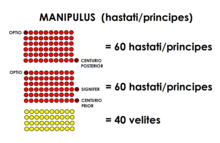Principes
 |
| Part ofa serieson the |
| Military of ancient Rome |
|---|
|
|
Principes(sg.:princeps) werespearmen,and laterswordsmen,in thearmies of the early Roman Republic.They were men in the prime of their lives who were fairly wealthy, and could afford decent equipment. They were theheavier infantryof thelegionwho carried large shields and wore good quality armor.[1]
Their usual position was the second battle line. They fought in aquincunxformation, supported by light troops. They were eventually disbanded after the so-called "Marian reforms"of the late Roman Republic.
History and deployment
[edit]According toPat Southern,principesappear to have been born from remnants of the old second class of the army under theEtruscan kingswhen it was reformed byMarcus Furius Camillus.[2]The second class stood in some of the first few ranks of a very largephalanxand were equipped in a similar manner toprincipes.They would support the heavier first class in the front ranks. It is probable that engagements with theSamnitesand a crushing defeat at the hands of theGallicwarlordBrennus,who both used many smaller military units rather than a few very large ones, taught the Romans the importance of flexibility and the inadequacy of the phalanx on the rough, hilly ground of central Italy.[3][4]
Fourth and third centuries BC
[edit]In the late 4th and early 3rd centuries BC, men were sorted into classes based on wealth, theprincipesbeing the wealthiest after thetriarii.[5]Principeswere armed with apilum,which is a throwing spear, and a sword, which was used after the spear had been thrown.[6]They fought in aquincunxformation, usually carryingscuta,large rectangular shields, and bronzehelmets,often with a number of feathers fixed onto the top to increase stature. They wore heavier armour types, the most common form beingchainmail,which offered a good degree of protection without hindering movement.[5]
According to Livy, in this type of legion, the 900principesformed 15maniples,military units of 60 men each.[1]Theprincipesstood in the second battle line, behindhastatiin the first line, and in front of thetriariiin the third.[5]In apitched battle,theleves,javelin-armedlight infantry,would form up at the front of the legion and harass the enemy with javelin fire to cover the advance of thehastati(light spearmen).[7]
If thehastatifailed to break the enemy during their engagement, they would fall back and let the heavierprincipestake over. If theprincipescould not break through, they would retire behind the heavytriariispearmen who would then engage the enemy in turn. Theequites,cavalrymen, were used as flankers and to pursue routing enemies. Therorariiandaccensiin the final battle line were some of the least dependable troops, and were used in a support role, providing mass and reinforcing wavering areas of the line.[7]
Polybian system
[edit]
By the time of thePunic warsof the 3rd century BC, this form of organisation was found to be inefficient. In a new Polybian system, infantry were sorted into classes according to age and experience rather than wealth, theprincipesbeing older veterans with a greater degree of experience.[8]Their equipment and role was very similar to the previous system, except they now carried swords, orgladii,instead of spears. Each princeps also carried twopila,heavy javelins that bent on impact to prevent them being removed from the victim or thrown back.[9]
Theprincipeshad been increased in number to 1,200 per legion, and formed 10 maniples of 120 men each.[10]Therorariiandaccensihad been disbanded.Leveshad been replaced withvelites,who had a similar role, with forty of them being attached to each maniple in the legion.[10]Pitched battles were conducted in a similar fashion; theveliteswould gather at the front and fling javelins to cover the advance of thehastati,who had also been re-armed with swords. If thehastatifailed to break the enemy, they would fall back on the principes. If the principes could not break them, they would retire behind thetriarii,who would then engage the enemy.[11]
This order of battle was almost always followed, theBattle of the Great Plainsand theBattle of Zamabeing among the few notable exceptions. At the Great Plains,Scipio,the Roman general, formed his men up in the usual manner, but once thehastatihad begun to engage the enemy, he used hisprincipesandtriariias a flanking force, routing the opposing Carthaginians.[12][13]At Zama, Scipio arranged his men into columns, side by side, with large lanes in between. The opposing Carthaginian elephants were drawn into these lanes where many were killed byveliteswithout inflicting many casualties on the Romans. Once the surviving elephants had been routed, he formed his men into a long line with histriariiandprincipesin the centre andhastation the flanks, ready to engage the Carthaginian infantry.[13]
Late republic
[edit]With theputative reforms of Gaius Mariusin 107 BC, intended to combat a shortage of manpower from wars against theNumidiankingJugurthainNorth Africaand Germanic tribes to the north, the different classes of units were disbanded entirely with legionaries uniformly armed withgladiusand twopilum.[14][failed verification]Auxiliaries,local irregular troops, would fulfill other roles, serving asarchers,skirmishersandcavalry.[15][obsolete source]
See also
[edit]References
[edit]- ^abSouthern 2007,p. 90
- ^Southern 2007,p. 89
- ^Penrose 2005,p. 29
- ^Southern 2007,p. 88
- ^abcSmith 1859,p. 495
- ^Forsythe, Gary (2005).A Critical History of Early Rome.University of California Press. p. 305.
- ^abMommsen, Theodor(1903).The History of Rome, Book II: From the Abolition of the Monarchy in Rome to the Union of Italy.Palatine Press.ISBN0-415-14953-3.
- ^Southern 2007,p. 92
- ^Mommsen, Theodor(1903).The History of Rome, Book III: From the Union of Italy to the Subjugation of Carthage and the Greek States.ISBN0-415-14953-3.
- ^abSmith 1859,p. 496
- ^Penrose 2005,p. 33
- ^Niebuhr, Barthold; Schmitz, Leonhard (1849).Lectures on the History of Rome, From the Earliest Times to the Fall of the Western Empire.Taylor, Walton, and Maberly. p. 151.
- ^abSekunda, Nicholas(1996).Republican Roman Army 200-104 BC.Men-at-Arms. Angus McBride (illustrator). Osprey Publishing. p. 20.ISBN1-85532-598-5.
- ^Southern 2007,p. 94
- ^Smith 1859,p. 506
Bibliography
[edit]- Penrose, Jane (2005).Rome and Her Enemies: An Empire Created and Destroyed by War.Osprey Publishing. p. 29.ISBN1-84176-932-0.
- Southern, Pat(2007).The Roman Army: A Social and Institutional History.Oxford University Press.ISBN978-0-19-532878-3.
- Smith, William (1859).A Dictionary of Greek and Roman Antiquities.Little, Brown, and Co. p. 496.ISBN0-89341-166-3.
